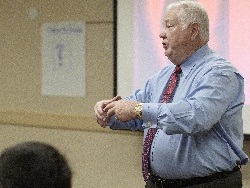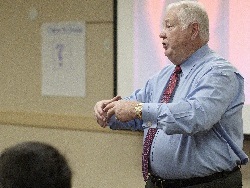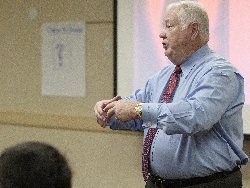Getting management support was the number one pain you said you had in your side as trainers in our informal April e-Zine survey. The following is a tried and true method developed by Bob Pike for getting managers to sign on to training ahead of time to make management a smaller thorn in your training side.
1. Eliminate objections in advance. There are only three objections to training:
- Time – it takes too much time or they don't have the time.
- Money – it costs too much money.
- People – we can't free up the people.
2. Develop several approaches (creative alternatives) to the objections.
- Time – break it into smaller chunks. For example – one hospital was short-staffed and the charge nurses felt that they couldn't let floor nurses off for a three-hour program. The trainer redesigned the three-hour program into four 50-minute modules. This allowed the program to be delivered in small enough increments that the nurses could be gone for one hour at a time (5 minutes to the class, 5 minutes back, and 50 minutes in class. (The additional time over the original three hours was required in order to add an appropriate open and close to the modules.)
- Money – perhaps other revenue sources can be tapped. One school partnered with a hospital to provide an in-service for both teachers and trainers. Neither had the budget alone. They had the budget together.
- People – The question here is one of value. People (including managers!) will do things to either avoid pain or gain pleasure. Generally we will do more to avoid pain than to gain pleasure. To have managers free up people willingly for training they either have to see the benefits to gain or the losses to avoid. This means that the training must be targeted to solve performance problems that are keeping managers from achieving department goals.
- Resources – offer to bring training to the workplace or use existing resources.
3. Get advance commitment on three things:
- What are the results that you want?
- What are the measures? These two questions may sound like traditional evaluation questions, but they are not. Managers can have strange ways of determining value. However in their minds the measurements are business measures. If the managers hold the purse strings for training we need to understand how they think on the issue of results. I learned this the hard way over twenty years ago. I got a call from the Training Director of a Fortune 100 company. He said that they had heard that I had an interpersonal skills program that was very effective. The problem was that they had 25 sales people not quite good enough to keep, not quite bad enough to fire. They wanted to put them through the program to see if it would help. On that basis I refused.
If you take people that the company has branded as “losers” and put them in a program together they'll spend their time justifying why it was their boss, the product, the territory, or some other outside factor that was responsible for their poor results. Besides, we don't develop training programs for losers. If the program worked we wouldn't start hiring people to the “loser's profile”!
We did, however, do the program on this basis. We took a cross section of the sales people – low, medium, and high performers – and put them through the program, along with 8–10 of their direct managers. The results were phenomenal. At the end of the first day, the training director thought he'd made a good decision. (I supported that belief, of course)! By the end of the second day the managers were calling headquarters. The vice president was so impressed by what he was hearing he decided to fly in for the final day.
At the luncheon that day he asked, “The enthusiasm is great, but how are we going to know this works?” I was feeling pretty cocky based on all the positive feedback we'd been getting in the first two days so I said, “We know what the sales results are of this group for the past six months. We'll simply track it for the next six months compared to people not in the program.” Simple isn't it? From an academic standpoint we have a treated group, a control group, and a variable – the training. Nothing could be easier to measure. His response was, “Well that's interesting. However, we're realigning territories, changing compensation, and introducing a new product line.” What he was saying is that we now have several variables and it becomes very difficult to prove how much impact any one variable has.
But that's ok. I'm a professional trainer and I have at least eleven ways to evaluate training. So I gave him a second one. He had a reason that wouldn't work. I gave him a third. He had a reason that wouldn't work. At first my table listened to this discussion. As I continued to try to satisfy his question, however, the entire lunch group became quiet and listened. The more I struggled, the more I felt my credibility slipping away.
Finally I asked the question I should have started with, “How would you measure it?” He said, “I don't think you can. I wanted to see what you had to say.” Then the lesson to be learned came from his next statement. He said, “Do you see the managers sitting here? They're responsible for results. If they tell me they want this program for their people, I'll see to it that they have the budget for it.” None of us would ever suggest that training results be measured by whether or not managers like it, but if that's what the person with the budget is looking for – that's what we need to look at as well. So part of my follow up with the managers was, “What do you want to see happen with your people that will tell that this program was worthwhile?”
By the way, twenty years later, with ongoing revisions, that client is still putting 300–500 people per year through that program!
- Who is going to measure and how will they be held accountable? Who do they usually expect to report the results? Who is best suited? Would the manager at your organization be more supportive of training efforts if transfer of training by their people were part of the manager's review? I think so.
4. Try the pilot approach. This means offering a program as a test ahead of a large-scale roll out. Whether it's developed internally or externally, this is a valuable step. It solidifies support for the program, demonstrates its value and importance, and allows it to be fine tuned for the people that will continue to take the program afterwards. There are thee important considerations for this step:
- Top management participation. Rensis Likert said that if you want to create change in an organization you need top management participation, not just top management support. Participation means that they're there and visible. They may send the letters of invitation, they may sit in on the program, they may attend executive briefings and be on advisory boards – all of things visibly demonstrate that top management considers this important.
- Cross-section of the organization. Often when managers are asked to send people to pilot programs they send the people they want to get rid of for a few days, not necessarily the people that could benefit the most – or the people that fit the profile for the program. You want the program to truly represent the people that would take subsequent offerings of the program. Make sure that you get management support for the selection/nomination process you want to use for attendees.
- Participants evaluate the whole. Even though this is a pilot program we don't want the participants dissecting the program minute-by-minute and piece-by-piece. There may be some things that happen in the program that don't make total sense at the moment, but make a lot of sense a while later. If we knit pick without giving the process a chance we hamstring ourselves. We want participants to look at the total package from the standpoint of how they could see others benefiting, how they themselves benefited, as well as how the delivery and content could be improved.
5. Phase I, Phase II, Phase III – The pilot program would be considered Phase I. The best time to start a second program is when enthusiasm for the first program is the highest. So, before the pilot ever takes place we want to try for a commitment to Phase II, based on the initial reception of the program. Getting this commitment in advance helps maintain the momentum. We want to build on both the momentum and the enthusiasm. While we're looking at the results back on the job from the pilot, let's conduct one or two additional programs. By the time those are completed we'll have on the job results from Phase I and if the results warrant it we can then roll out more offering of the program in Phase III.






